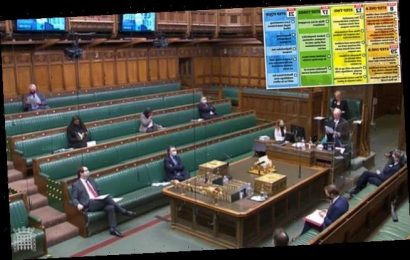CORONAVIRUS infections in England are showing signs of slowing after the country was separated into a three tier lockdown system.
Data from the Office for National Statistics (ONS) shows that England recorded 35,000 new cases of the virus a day from October 10 to 16.
⚠️ Read our coronavirus live blog for the latest news & updates
Last week it was reported that there were an average of 27,900 new cases a day and this figure was a 62 per cent increase from September 25 to October 1.
The figures released today from the ONS are based on statistical modelling and show that while the incidence rate has increased in recent weeks – cases are starting to level off.
The three tier system started in England on October 14 and the government set up a postcode checker which allows people to check what lockdown area they are in.
Commenting on the ONS figures Prof James Naismith, director of the Rosalind Franklin Institute, and University of Oxford said the new report was "hopeful".
“The ONS figures estimate an increase of 27,900 to 35,200 cases per day for the week ending October 16.
"This is not as fast as before, it gives a doubling time of around 21 days.
"There is some unavoidable uncertainty in these measurements, so it is too early to draw firm conclusions as to whether the rate of increase has really decreased but it is hopeful."
Estimates from the ONS state that in the last week there were 6.46 new infections per 10,000 people.
Despite experts earlier this week claiming that infection rates had been dropping across younger age groups, the ONS data states that infection rates remain high in older teenagers.
Some experts have cast doubt over the apparent levelling off of cases, with one saying there was "no good news".
Prof Kevin McConway, a statistician at The Open University, said: "There isn’t much in it in the way of good news.
"The estimate of the number of people in the whole English community population that would test positive for the virus has continued to increase, still with no clear sign that the rate of increase is slowing."
The report also estimates that from October 10 to 16, 433,300 people were infected with the virus in private households – this figure excludes care homes.
Graphs produced by the ONS show that kids in school year 12 – up to those aged 24 have the highest rates of infection in the country.
The graphs show that there has also been a small increase in primary school aged children – in aged two to year 6.
Cases have remained relatively flat in people aged 25 to 34 and there seem to have been a small dip in cases in those kids in school year 7 to 11.
The ONS reported stated: "There has been growth in the Covid-19 infection rate in all age groups over the past two weeks including those aged over 70 years, with the current rates highest in older teenagers and young adults.
"Extreme caution should be taken in over-interpreting small movements in the narrower age groups, particularly those in school Years 7 to 11, which have wider credible intervals", it added.
Regional analysis
Looking at the cases by region and the ONS said that there has been an increase in positive tests in most regions over the last two weeks.
It states that rates in the North West and Yorkshire and The Humber are continuing to grow but added that the South West has not seen the same growth levels as other regions.
The report stated that cases in the North East are showing signs of levelling off.
Graphs provided by the ONS show the levelling off in the North East and show increases in the North West, Yorkshire and The Humber, The West Midlands, East of England, London and the South East.
Both the East Midlands and the South West appear to have experienced a drop in case loads over the last two weeks.
Looking at antibody tests on a regional basis and the report states that there is clear evidence of variation between regions, with the highest antibody positivity seen in London.
London was hit hard by the virus at the start of the pandemic and it was previously reported that some Londoners may have achieved herd immunity.
London is followed by the North East, Yorkshire and The Humber, and the North West.
Most read in Health News
Booster myth busters 
Some of us have questions about vaccine top-ups. We ask the experts

Combining lime with Viagra makes drug up to four times more potent

Major change to Covid booster jabs from Monday as PM set to ease restrictions

NHS rule change could see MILLIONS charged for prescriptions they now get for free
Prof Naismith added that the disease is very hard to track and trace and his comments come after Prime Minister Boris Johnson demanded improvements to the service after it was found that just one in seven people get their results back in 24 hours.
Speaking at a press conference last night Mr Johnson said: “We need to make sure that people who do get a positive test self-isolate. That’s absolutely crucial if this is going to work in the way that it can.”
Prof Naismith added: "Testing identified less than half the people who got infected in the week ending 14th October.
"This is a disease which is asymptomatic for the majority and rapidly spread. It is very hard to track and trace."
Source: Read Full Article















